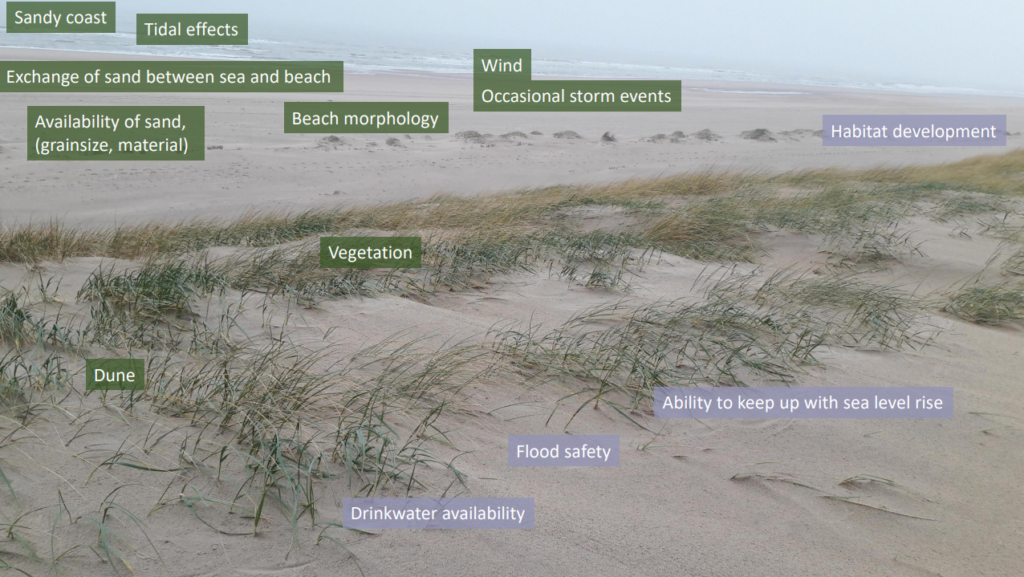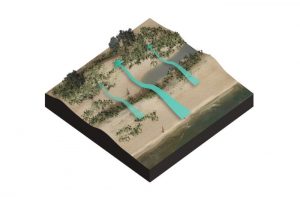Get Started
In this ‘Get started’ section, the driving physical and ecological processes in dune systems are described. Furthermore, different types of dune dynamics are described as well as the human influence on coastal dune systems. This is necessary to understand the behavior of a natural dune system as well as the influence of coastal zone management on this behavior.
In short: the benefits of enhancing dune dynamics

Dynamics are necessary to create the right conditions for several biodiverse dune habitats to develop and sustain. Without the influx of sand, dominant fast-growing species such as shrubs will colonize the dunes and reduce the diversity in habitats and species. In addition, enhancing dune dynamics also increases the possibility that the dunes ‘grow’ with sea level rise with sand ending more land inward and higher up in the dune (Osswald et al., 2019). A summary of the boundary conditions and the benefits of enhancing dune dynamics are presented in Figure 1.
Physical processes in a coastal dune system
Coastal sand dunes are mostly located in coastal regions where sand prevails as the dominant sediment type and where the dominant wind direction is landward. The size and morphology of coastal dunes depends on the interaction between processes of sedimentation and erosion, vegetation, and the characteristics of the nearshore and beach environment (Sloss et al., 2012). Vegetation plays a key role in the development of coastal dunes; it traps sediment and as such helps to build up a dune system.
Natural sediment transport by wind (aeolian transport) causes sand from the dry beach to be blown into the dunes where it may be captured by vegetation. This may lead to growth of the dune system or/and add to ecological value of the dune system. Growth of the dune system (either by seaward expansion due to growth of dune foot/embryo dunes or by heightening due to growth of the dune top) increases coastal safety. During extreme events such as storm surges, dune erosion can occur. Whether a dune system expands seawards or erodes over time depends on its dynamic equilibrium between erosion and accretion. Some dune systems are predominantly eroding because they have a more seaward location than the balance between hydrodynamic and aeolian processes dictates (Figure 2).

Zonation and succession in a coastal dune system
A coastal dune system can be divided in different zones that differ in (the dominance of) physical and ecological processes, resulting in different habitat types. These zones show an ecological succession, from embryo dunes on the high beach with pioneer species, via a mosaic of white dunes, dune meadows and dune slacks to shrublands and eventually forest land inward (Figure 3). Succession is the sequence of organisms that succeed after each other in an ecosystem until it reaches a climax community (Newman, 2020). A key feature of dune vegetation is the sequence of different vegetation communities or zones that occur with increasing distance landward. Each zone in the vegetation sequence has a different species composition that is related to the ability of the plant species to withstand environmental factors prevailing in that zone. The physical processes that determine where and in what form these habitats occur, are:
- sand transport,
- salt-spray,
- chemical conditions of the sediment and ground water (e.g. calcium content),
- relative influence of seawater, and
- groundwater and nutrient availability.
For vegetation to become established, pioneer species must cope with occasional storms and extremely stressful conditions (heat, salt spray, low nutrients and lack of fresh water). However after having been established, pioneer species can build up an embryo dune that can together grow into a foredune. This foredune reduces the stressful conditions for colonization in areas behind it, the secondary dune or hinterdune, by less stress-tolerant species.
Typical dune habitats include the beach, embryo dunes, foredune and older hinterdunes. In humid valleys between the dunes, dune slacks can occur. From the foredune towards the hinterland, biotic factors (vegetation) become increasingly important by trapping the sand and stabilizing the dunes (Olson 1958, Hesp 2002, Davidson-Arnott 2010). When the influence of disturbance (sand transport, grazing) is limited, succession leads to the establishment over time of grassland (grey dunes), shrubs, and eventually forest. High nutrient loadings (e.g. by atmospheric nitrogen deposition) will increase the succession rate and reduce biodiversity (Figure 3).


Habitats and vegetation types that depend on (some level) of dune dynamics are grey dunes (dune meadows) and dune slacks. The white dunes (front dune row with marram grass) also depend on dune dynamics, but white dunes are not threatened in existing dune systems because they are usually naturally dynamic. However, when a dune system has largely or entirely disappeared, restoring dune systems will start with restoring the white dunes. Only after some years, dune slacks and grey dune habitats can develop behind these restored dunes.
White dunes are dominated by marram grass and depend on the influx of sand. Marram grass is well adapted to these high deposition rates and will grow vertically with an extended root system as a response. In fact, the species is dependent on this influx of sand, and the species will be less vital and eventually disappear in the dune landscape landward, where the dune dynamics decline.
Dune slacks can be formed in two ways: When a row of embryonic dunes forms a new dune ridge on the beach. The isolated part of the (former) beach between the old foredune and the new dune ridge can develop into a dune slack. In the hinter dunes, a blowout can become so large and deep that it reaches the groundwater table, creating moist conditions for dune slack vegetation. Grey dunes, or dune meadows, are characterized by nutrient-poor soils with a high diversity of low moss and plant species. This vegetation type can only endure/persist when a sand is blown into the habitat to prevent nutrient levels to get too high. Additionally, grazing (by e.g. rabbits) is important to keep the vegetation short and to create small open spots of bare sand.
Human influence on coastal dune systems
In different places around the world, coastal management traditionally focused on dune stabilization or on dunes replacing artificial hard constructions such as dykes to provide coastal safety. Stabilizing (fore)dunes is done through trapping sand by placing artificial structures (brushwood screens) and additional marram grass planting. This resulted in high and continuously vegetated foredunes, physically separating the beach (the main source of sediment input) from the hinterdunes. As a result, the natural dynamic processes of sediment transport, erosion and deposition have diminished, leading to a loss of biodiversity in these areas (e.g., grey dune and dune slack habitats being overgrown by scrubs) and a loss of rare plants and invertebrates that require open dynamic conditions (Schwarz et al, 2018).
Because the early-succession stages of dune habitats can only exist in dynamic environments, the stabilization of dunes has led to a decrease in biodiversity and a loss of valuable dune habitats such as dune slacks and grey dune grasslands. In some locations (especially near big cities), the dunes have been removed entirely and are replaced by dykes or other hard infrastructure. As a consequence, natural values and other functions of dune systems are lost.
Morphological elements of dune dynamics
Typical morphological examples of dune dynamics in coastal dune systems are: development of embryo dunes, a foredune with drifting sand and blowouts, notches and a parabolic dune system (Figure 4 & Table 1). Examples where dynamics of water play a role, are a washover and a tidal inlet. Each of these types has its own characteristics and not all types can be applied on every location. E.g. on locations with a small dune system and densely populated areas closely behind the dune system, a washover or tidal inlet is not a good strategy to opt for. Monitoring and maintenance of these dynamic dune elements is necessary and will be discussed in the ‘How to use’-section of this concept.


| Type | Short description |
|---|---|
| Embryo dunes (or incipient foredunes) | Embryo dunes or shadow dunes are dry beach features (above mean high water/wrack lines) that are formed by wind deposited sand on and leeward of wrack lines, flotsam, vegetation, driftwood and debris. Embryo dunes can form embryo dune fields and become the seaward edge of future foredunes (Craig et al, 2012). |
| Blowout | Blowouts (stuifkuil in Dutch) are erosional dune landforms that are typically trough-, bowl-, or saucer-shaped depressions or hollows formed by wind erosion of a pre-existing sandy substrate or dune. The breaching may occur naturally after erosion of the foredune by storm waves or by funneling of winds through saddles (lows) in the crest of a high foredune, or wherever there is a reduction in the vegetation cover (Craig et al, 2012). When a blowout increases in size and an opening to the beach appears we call it a notch (kerf in Dutch) (Arens, 2010). |
| Foredune with notches and drifting sand. | Just landward of the embryo dunes are the older and slightly higher dunes called foredunes (Craig et al, 2012). In case of drifting sand, the foredune consists of patches with and without vegetation, and local differences in relief and geomorphology. Notches can be present in the foredune, that allow sand being drifted to the hinterdunes. Notches might grow bigger into big openings through the foredune but can also degenerate when vegetation starts to recolonize the notch. The areas are usually vegetated with marram grass species that need the entrapment of sand for vital growth. |
| Parabolic dune | Continued transport of sand through blowouts can result in the development of parabolic dunes (Craig et al, 2012). |
| Washover | This is the flow of water (and sediment) over a coastal dune during storm events. |
| Tidal inlet | An opening in the dune system with sea water flowing in at high tide. |

